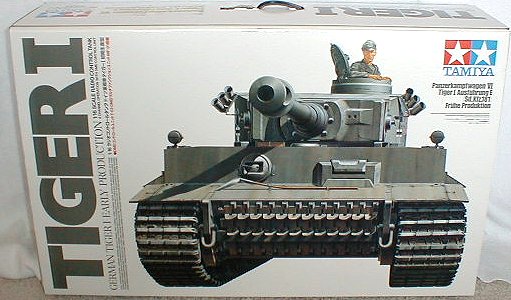
|
KIT: |
Tamiya 1/16 Tiger I 'Early Production' |
|
KIT # |
56010 |
|
PRICE: |
$906 Euro |
|
DECALS: |
3 versions |
|
REVIEW & |
Andre Kamsteeg |
|
NOTES: |
Full option version remote control tank scale 1/16. Batteries and 4-channel transmitter are needed to operate the tank. Photos taken with my Olympus Camedia C-860L digital camera. |

|
HISTORY |
The Tiger tank is one of the best-known tanks of World War II. Although the numbers built were never enough to stop the flood of tanks of the allies, they made an impact that is far greater than the numbers that were available at any given time on the battlefield. The design of the Tiger started in May 1941, before the first encounters with the Russian T34’s and KV1’s. The Germans did not learn the lessons of the T34 yet, so the Tiger did not have any sloped armor, but the combination of up to 110 mm armor and the 88 mm KwK36 gun made it a very potent weapon.
The problems that plagued the tank had to do with the weight (56.900 kg) and
size. The Tiger was too wide for normal rail transport so special tracks had
to be used when moving it to and from the battlefield by train. In that case
the outside road wheels of the early Tiger had to be removed. It also took 3
or 4 FAMO halftracks to recover a Tiger tank. One of the most famous actions
involving a Tiger occurred on the 13th of June 1944 near Viller-Bocage in
Normandy where Michael Wittmann destroyed 25 British vehicles including
Cromwell tanks in about 10 minutes with a single Tiger.
On the other hand the British in Tunisia captured the Tiger that is now in the
Bovington tank museum. The tank had been hit with a single shot that slightly
damaged the gun and then got stuck underneath the turret, preventing the
turret from rotating. This tank could have easily made it back to the German
line where the damage could have been repaired, but the crew got frightened
and left the almost intact tank to the enemy.
|
THE KIT |
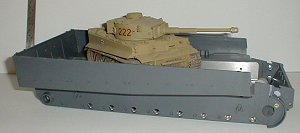 |
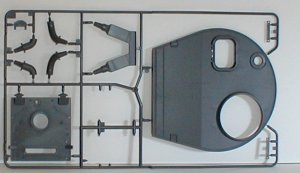 |
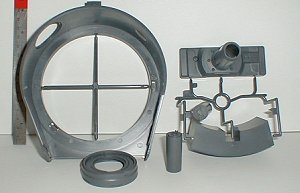 |
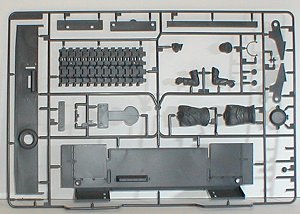 |
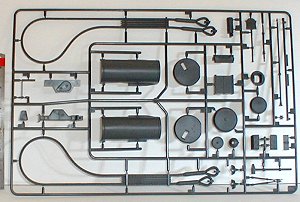 |
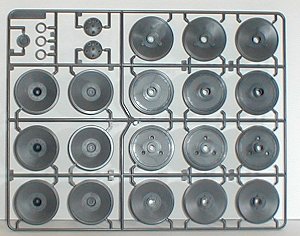 |
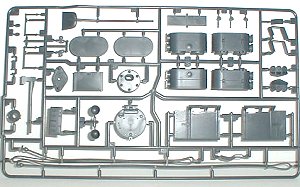 |
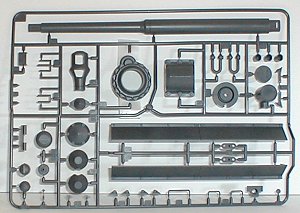 |
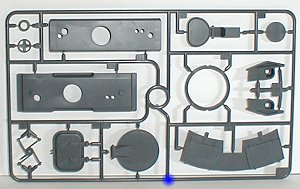 |
This kit is big (I hope to use this word only once in this preview, but this will be difficult). I normally built 1/35 vehicles and 1/48 airplanes and that does not prepare you for this kit. To show the difference in size, I put an Italeri Tiger I (not completely ready yet) in the lower hull. The box measures 29 x 18 x 7 inches (about 74 x 47 x 18 cm) so you better ask your significant other first; no way to sneak this one into the house unnoticed. For convenience the box has a handle so it can be carried as a suitcase.
I got the full option version and according to the box this means gun and hull
will recoil when the gun is fired. There will be light effects when firing
either main gun or hull machine gun. And full sound effects for both firing
and engine. The Tiger II in Saumur has been sampled to provide the sound for
the engine.
The instructions are in the usual Tamiya stile: an A4 sized book of 40 pages.
The first 7 pages consist of a history in Japanese, English, German and French
plus warnings about building and running the tank. The next 20 pages contain
the 45 step building instructions including the installation of the mechanics
to operate the tank. Then 6 pages about running the tank and trouble shooting,
3 pages of painting guide and finally 4 pages with the parts list. Also two
small pieces of paper are provided. One with changes to the instructions and
one with an extra warning to tighten screws in the track gearboxes. The
changes to the instructions are not to use screws when fitting one part E27
but glue, although the other two parts E27 should be constructed with the
screws. Also no grease should be used on the gearboxes for the turret rotation
and the gun elevation.
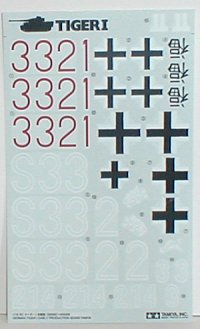 The kit itself consists
of 11 injection molded sprues (sprue A 3 times, and E 2 times) with a total of
over 250 parts (see pictures, the ruler is 6 inches (15.2 cm) from the bottom
to the red line). The ejector pins on the different parts are placed where
they won’t show when the model is built. In my example sprue D is a little
warped, but I don’t expect any problems from that, because the warp is more
between the parts than affecting the parts. According to the parts list in the
instructions, not all parts are needed. One part looks like a seat for the
turret and also a barrel for a machine gun is not used. These might be used in
the version without all the option or otherwise for the static model that is
rumored on Internet. This rumor is not completely impossible because Tamiya
also released a remote control and a static model of the Kübelwagen in 1/16.
The kit itself consists
of 11 injection molded sprues (sprue A 3 times, and E 2 times) with a total of
over 250 parts (see pictures, the ruler is 6 inches (15.2 cm) from the bottom
to the red line). The ejector pins on the different parts are placed where
they won’t show when the model is built. In my example sprue D is a little
warped, but I don’t expect any problems from that, because the warp is more
between the parts than affecting the parts. According to the parts list in the
instructions, not all parts are needed. One part looks like a seat for the
turret and also a barrel for a machine gun is not used. These might be used in
the version without all the option or otherwise for the static model that is
rumored on Internet. This rumor is not completely impossible because Tamiya
also released a remote control and a static model of the Kübelwagen in 1/16.
Apart from the injection molded parts you will find 5 bags of screws with in
total 239 parts, 48 rubber tires for the road wheels, 8 metal parts for
sprocket and idler, shafts, torsion bars, bearings and some tools.
The tracks are assembled but you get 5 link pins and 8 track links as spares.
Strangely enough you have to take links out of the track when attaching them.
Also included are the parts to operate the tank. A speaker unit, a multi
function unit, a control unit, 2 assembled gear boxes with 380 type motors, a
recoil unit, a gun elevation unit and a turret rotation unit. Also some flash
units for main gun and hull machine gun. In total an awful lot of parts to
play with.
|
CONCLUSIONS |
|
REFERENCES |
If you would like your product reviewed fairly and quickly by a site that has thousands of visits a day, please contact me or see other details in the Note to Contributors.